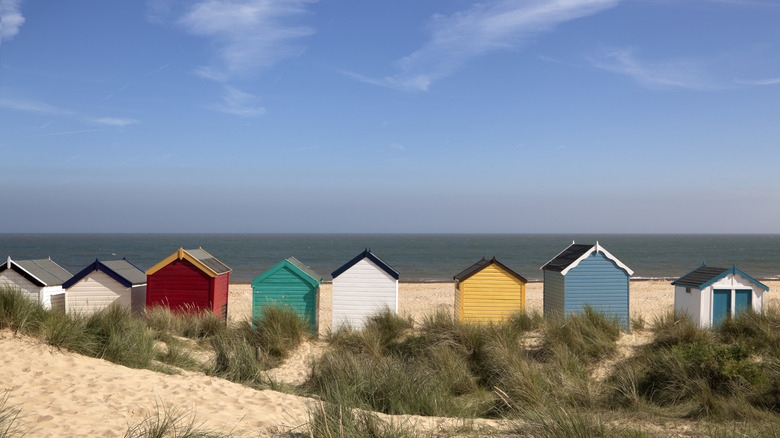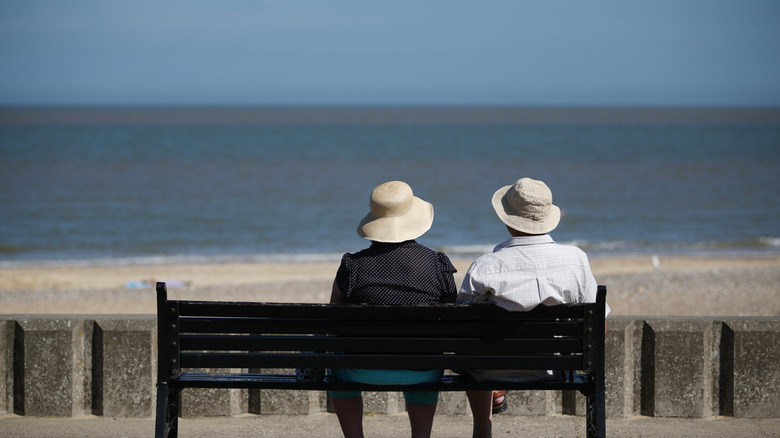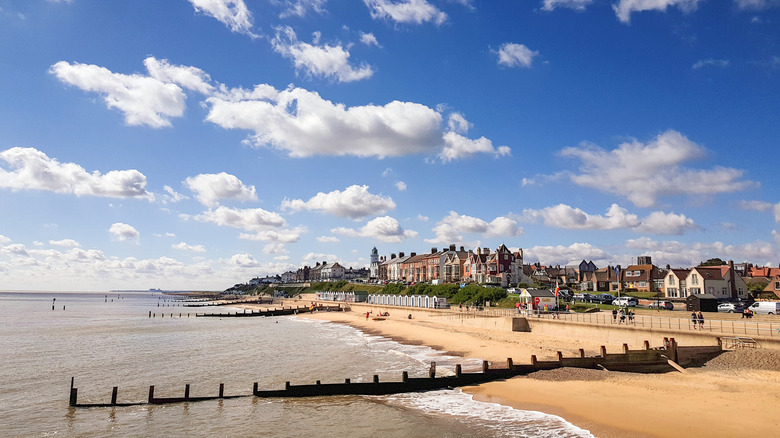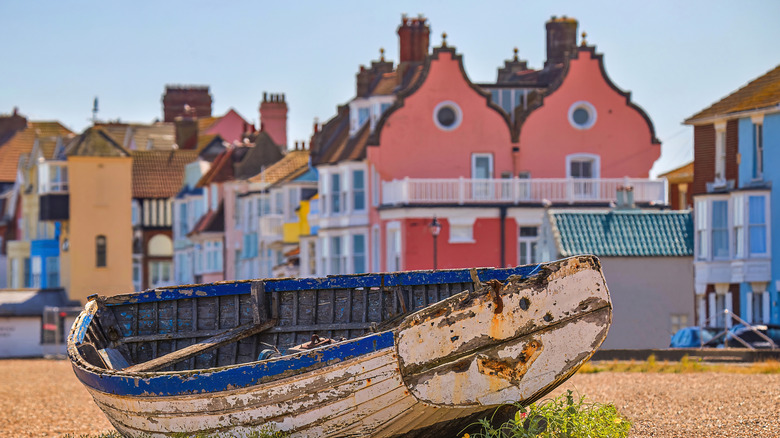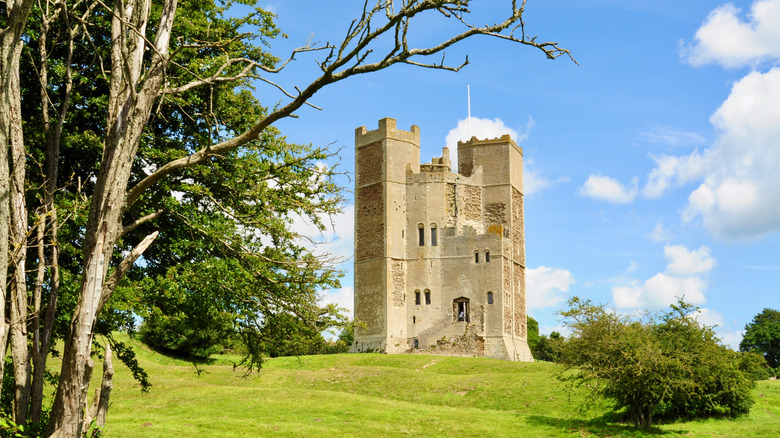A Quiet Coastal Retreat In England Offers Castles, Beaches, And Fresh Seafood Feasts
England and the seaside go together like fish and chips but when visitors think of beaches, their attention is often drawn to old-school resorts like Brighton and Blackpool or the cove-pocked shorelines of Devon and Cornwall. Yet the quiet rural county of Suffolk has plenty to offer beachcombers and holiday-makers with miles of atmospheric coastline to explore, ranging from classic seaside towns to remote stretches with barely a soul in sight. Also add beautiful countryside, stunning castles, and excellent seafood, and you've got yourself an underrated gem ideal for a day trip if you're staying in London.
The gateway to Suffolk is the county town of Ipswich, which is around a two-hour drive from London and even quicker to reach by train. Driving is recommended, however, because public transport is slow infrequent once you get out into the countryside. It isn't called Sleepy Suffolk for nothing, and you will feel even further from the Big Smoke once you get out onto the narrow country roads and lanes that wind through fields, villages, and woodland. If you plan to stay over and make the most of it, budget options are few and far between along the coast but a night's stay in a 3- or 4-star Suffolk hotel costs on average $120-$160 a night. To enjoy the best of the region's lovely pubs and restaurants, budget for up to $50 for a main course in the picks we've selected here. Let's take a look and some of the highlights.
Ipswich to the Suffolk coast
Ipswich is Suffolk's largest urban center and it is the gateway to the rest of the county. It is around 12 miles from the sea but it feels a lot closer — while the River Orwell flows out to the English Channel, its broad estuary brings a coastal air into the heart of the town. You can really feel it on the Waterfront where sailing boats are moored and seabirds whirl overhead. It is a pleasant place for a stroll and many of the town's best eateries are found here. The Last Anchor, the Eaterie @ Salthouse Hotel, and Mariner's are all good spots for a decent bite — the latter is especially suited to our coastal theme, located on an old 19th-century ship.
On the other side of Ipswich, two routes will take you to the seaside proper. The A14 leads to Felixstowe on the southern tip of the county while the A12 takes you up past the charming market town of Woodbridge towards Lowestoft on the top end of the Suffolk coast near the border with Norfolk. Both are classic English seaside towns with penny arcades, chip shops, sticks of rock, and Victorian-era piers stretching out to sea. They are a little faded, much like many similar resorts around the U.K., but they are still fun reminders of the days when Brits would flock to the seaside for their holidays. Starting at Lowestoft, our journey works its way south back towards Ipswich and London.
Southwold, Walberswick, and Dunwich
The beautiful Suffolk Coast runs for around 50 miles in between Lowestoft and Felixstowe. It is sparsely populated and traverses heathland, nature reserves, caravan parks, eroding cliffs, and stretches of isolated beach. One of the best ways to see it is by hiking the Suffolk Coast Path linking the region's picturesque seaside towns and, incongruously, taking you past the ominous bulk of Sizewell B nuclear power station.
First stop is Southwold, a classy little seaside town known for its gorgeous sandy beach, rows of colorful beach huts, lovely harbor, and working lighthouse. You'll never be far away from some decent fish and chips and beer lovers can take a tour of the famous Adnams Brewery. A little further south is the village of Walberswick where the Sole Bay Fish Company shack is a great place to enjoy fresh crab before taking the rowboat ferry across the River Blythe.
Continuing south with the sea on your left you will come to Dunwich, an eerie village known as Britain's Atlantis. It is perhaps the most atmospheric spot on the Suffolk Coast precisely because there is nothing really there. Vast emptiness occupies the space where a bustling seaport once was before the waves claimed it many centuries ago. Now there is only a few houses, a very good pub, a ruined friary, and a lonely stretch of shingle beach. From spring until fall, Flora Tea Rooms has been luring visitors with its fish and chips and seafood specials for decades.
Thorpeness, Aldeburgh, and Snape Maltings
Continuing south through RSPB Minsmere nature preserve and past the nuclear power station, our route brings us to Thorpeness, another quiet seaside village popular with families and people looking for a bit of peace and quiet. Here, a tiny fishing hamlet was transformed into a whimsical holiday destination by architect Glencairn Stuart Ogilvie in 1910. He built gorgeous seafront houses, a golf club, the landmark "House in the Clouds" water tower, and turned a flooded area into the Peter Pan-inspired boating lake that still attracts visitors today.
A few miles further along the coast is Aldeburgh, a larger nostalgic resort that has become a foodie destination in recent years. Book a table at The Suffolk, an upscale but welcoming restaurant with a focus on the freshest locally-caught seafood, or enjoy similar fare with sea views at Brudenell Seafood & Grill. For more no-frills eats, Aldeburgh Fish & Chip Shop has been serving deep-fried delights since 1967 and is beloved as one of the best chippies in the U.K.
From Aldeburgh, it is worth taking a detour inland to Snape Maltings. These Victorian-era brick buildings on the River Alde have been converted into a world-class center for the arts and has hosted the Aldeburgh Festival (founded by Benjamin Britten and Peter Pears) since 1957. The complex is open all year to visitors and has a wealth of shops and great places to eat, and also check the schedule if you fancy catching a live music event.
Orford and Framlingham have lovely castles
Suffolk isn't overly abundant with castles but the county does have two must-see examples on the home stretch. The first is the proud Norman tower standing solitary on its mound on the edge of Orford, a really interesting fishing village that is home to some excellent pubs and Pinney's, a family-run shop that has been smoking its own seafood since the 1950s. The castle is a wonderfully preserved 12th-century keep with an unusual 18-sided design which is great fun to poke around, especially with kids. If you feel in the need for even more isolation after your journey along the Suffolk coast, book yourself a spot on the ferry to Orford Ness. The protected shingle spit is dubbed Britain's Area 51, closed to the public for decades due to military testing. Now the haunting ruins of top-secret research facilities stand in stark contrast to the windswept shore.
15 miles inland Framlingham, you will find a castle that looks as if it has been forcibly separated from the tower at Orford by a giant hand. While Orford is a keep that has lost its curtain wall, Framlingham is a magnificent turreted curtain wall without a central keep. A walk around the top of the walls offers great views across the surrounding countryside. Once you're done, the Station Hotel is perhaps the pick of the lovely market town's many cozy spots for some quality pub grub with a regularly-changing menu.
